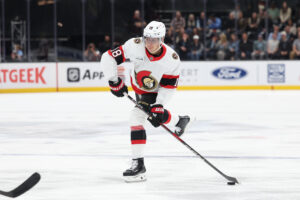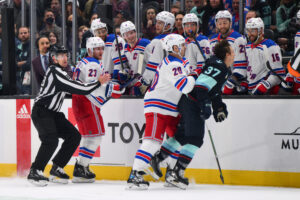Chris Kreider has been a mainstay on the New York Rangers‘ forward core since the moment he arrived in the NHL. With the trade of Mats Zuccarello back in early 2019, Kreider also became the longest-tenured Ranger forward. This season he played alongside his good friends, Mika Zibanejad and Pavel Buchnevich. Chris Kreider put up 24 goals and 21 assists for a total of 45 points in 63 games. That was on pace for a career-high 59 points.
Throughout the process, he earned himself a lucrative $45 million deal on trade deadline day. Although many believed he would be traded. While his point totals suggest he was playing the best hockey of his career, the intricate details surrounding his play tell another tale. Needless to say, Chris Kreider’s 2019-20 campaign was a good one. However, it was also quite an odd one.
What Changed In 2019-20 for Chris Kreider
Defensive Impact
Although he had never received recognition for it, Kreider had quietly been a great two-way forward throughout his career. In terms of EVD-GAR (even strength defence goals above replacement), Kreider was third amongst team forwards in 2016-17. As well as second in 2017-18, and 2018-19. Then, this season he was second to last amongst team forwards. He was in front of only Kaapo Kakko, and eighth to last amongst league forwards.
For the sake of comparison, above is Kreider’s cumulative RAPM chart from 2016-19 (left). This is next to his RAPM chart from 2019-20 (right). Evidently, he allowed a higher quantity of chances this year compared to before. He also did not restrict the quality of those chances at all. Even his offensive generation went down, as he created a lower quantity of chances with less quality. However, he also managed to do this while somehow scoring at an unusually high rate.
Back to the assessment of his EVD rank amongst Rangers forwards, directly in front of Kreider was Mika Zibanejad. He ranked 13th on the team after ranking top four in the two years preceding. Interestingly enough, both Kreider and Zibanejad were riding career-high shooting percentages and career-low defensive impacts. All while putting up career-high rates of point production. Perhaps the duo simply decided to shift their focus completely on the offensive side of the game this year. Whatever it was, hopefully for the sake of the Rangers’ goaltenders, they pick up defensive responsibility again.
Transition Metrics
In terms of his performance in transition, Kreider struggled mightily there as well. He was not efficient in moving pucks into the offensive zone and out of the defensive zone. He also did not do much in terms of shot contributions this year.
As illustrated above, when comparing Kreider’s metrics in the transition game from 2018-19 to 2019-20, a clear drop off can be seen in almost every category. His inability to enter the offensive zone goes hand in hand with his struggle to consistently generate high-quality chances. His inability to exit the defensive zone goes with his struggle to consistently prevent high-quality chances against. On the whole, there isn’t much explanation as to why he struggled in transition. However, much like his defensive play, Kreider needs to return to the form Rangers fans know he is capable of.
Powerplay Performance
Unlike his complete drop-offs in defensive play and transition ability, Kreider maintained his great form on the powerplay. In 63 games, Kreider notched 13 points on the powerplay. This is compared to 12 power-play points in 79 games the year before. His PPO (powerplay offence goals above replacement) was 2.4 in 2019-20 compared to 2.5 in ’18-19. Considering how small the change was, Kreider can still be a top-end contributor on the powerplay. Night in an night out, he provided a great net-front presence and had a hand in many of the Rangers’ goals despite not getting points for all of them.
What This Means for Chris Kreider
Many may see this as a reason to worry about his contract extension which lasts for seven years until he is 36 with an annual average of $6.5 million. Although this analytical down-season may seem like a cause for concern, it most likely has nothing to do with Kreider’s age or abilities. Considering how Zibanejad also lost his two-way touch and did not drive play as well as before, it most likely was due to some factor in the team playstyle or simply just a down-season in terms of those categories.
Knowing that this peculiar season is most likely a one-time thing rather than a continuous pattern, Kreider can certainly return back to the top-line calibre winger he is known to be. Going forward, of course, there will be regression as he ages. However, that should not be a worry until the last few years of his contract, especially considering his great discipline, self-maintenance, and work ethic. Ultimately, this interesting season is certainly something that should be looked into by the Rangers management but definitely not a reason for fan panic.
Main Photo:






